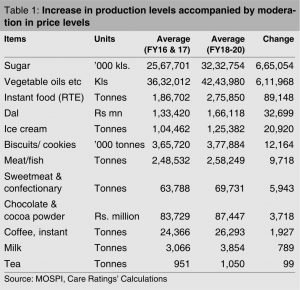For a category like processed food, it has to grow when the population is increasing and more so if we take the migrant population also into consideration. However, the reality is that it is declined in the year 2019. Lower Consumer Demand Resulting in Declined Production and Consumption of Processed Food, analyses Rajat K Baisya.
The year 2019 was a difficult year both for the economy as well as for our processed food industry. Quarter after quarters Gross Domestic Product (GDP) was declining and the latest projection for GDP growth is about 5%. Some of the key food ingredients like sugar, oil, tea, coffee, and milk have reported an increase in production (Table 1) but processed food in FMCG sector which is generally considered as a very important constituent of our GDP is definitely showing a negative growth rate as determined from their decline in production level (Table 2).
Index of industrial production (IIP) and the data from the Ministry of Statistics and Program Implementation (MOSPI) are definitely signaling to that conclusion. The figures reported in this article are compiled and worked out by the Care Ratings Agency. They have, however, reported the figures for a wide range of FMCG products but I have picked up those relevant for the processed food industry.
In one of my earlier articles in this column, I have suggested that businesses in the processed food sector under MSME should explore other avenues of growth including exporting to neighboring economies. Large companies offer discounts and trade schemes including consumer schemes to liquidate the stock in the year-end implemented through high pitch promotional schemes.
However, the large numbers of MSME players who are operating in a limited and defined geographical area(s) and not on a pan India basis cannot take such initiatives for the reason that they don’t have any brand pull. They sell and thrive by pushing their products through trade channels mainly by soliciting support from trade channel partners and more importantly from the retailers. They have suffered from the slowdown in the economy in the year that has just ended.
In spite of the fact that some of the basic food ingredients’ production has increased production of processed foods has decreased. There are two reasons which have triggered that decline. One is the prices of the food ingredients including raw materials like fruits and vegetables have increased which has pushed the cost as well as the price up for the finished products. And the second reason is consumer demand has gone down and expenditure and consumption of processed products has also declined.
Industries have kept the price of some of the products the same but in spite of that production of some of the items have declined (Table 2). Products like aerated waters also declined for the reasons that people have become more health-conscious now and the younger generation who are the major consumers of these products are no longer consuming that much.

As per MOSPI figures, there is a decline in the production of some items which are either stable or even increase in inflation rate as shown in Table 3.
Processed foods although considered by many as essential and helping the country by reducing the wastage but the purchasing power of the consumers have still kept it out of reach from the bulk of the population and in that sense, it is still a product for the upper-middle class and middle class.
In spite of that industry was thriving and delivered double-digit growth triggered by the introduction of many new categories in health and savory food segments but the year 2019 has not gone well for the processors and there is an overall decline in consumption of processed food. The industry as such shown a de-growth.
There are several reasons for that and that includes demonetization and poor implementation of GST in addition to the poor performance of the economy and the recent unrest on account of CAA and NRC. The industry has still not benefitted from the unified tax regime under GST and there are a couple of reasons for that including poor infrastructure. Industrial credit has gone down, industrial production also has gone down. Companies after companies reported poor performance and banks reporting highest-ever NPAs. Cumulatively, these have influenced the food industry as well.

This year we had more numbers of regulatory lapses and even cases of food adulteration reported right here in the capital city Delhi where the headquarter of FSSAI is located. No new investment or new launches took place in the year that has just gone by which can be worth mentioning.
For a category like processed food, it has to grow when the population is increasing and more so if we take the migrant population also into consideration. However, the reality is that it is declined in the year 2019. And the reason, people have consumed less and some people have not even consumed anything and that gets also reflected in consumption expenditure figure on processed food reported by CMIE.
The year 2019 was thus not a good year for our industry. We can look forward to the better in the year 2020. I wish all PFI readers a very happy, joyous, peaceful, and prosperous new year 2020.
The author is the chairman of Strategic Consulting Group and served as Professor and Head of the Department of Management Studies, IIT Delhi. His research areas are marketing, strategy, project management and international business and he is an internationally well-known consultant in these areas. Prof Baisya is also the president of Project & Technology Management Foundation.
















